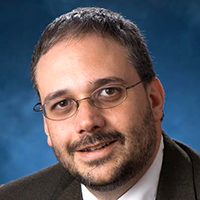While the incubator was silent on Oct. 8 – no thin layer of cardiomyocytes contracted in a steady beat – national journalists still got a feel for the innovative pulse running through Jeffrey Jacot’s bioengineering lab.
About 20 Science Writers conference participants joined Jacot, PhD, associate professor of bioengineering, for a tour of the facility where his team conducts research in the University of Colorado Center for Bioengineering at the CU School of Medicine.
In his lab for pediatric regenerative medicine, Jacot collaborates with surgeons, clinicians, radiologists, biologists and other CU Anschutz colleagues to better understand and work toward solutions for pediatric patients with congenital heart defects. His team specializes in engineering biomaterials that direct stem cells, collected from amniotic fluid, to build reparative 3D, laboratory-grown heart tissue.
Severe heart defects in newborns come in various forms and they are complicated to repair. Patches, typically made from plastic, have been developed for some defects, but “people with some sort of artificial patch in the heart have about a 1,000 times greater chance of developing fibrillation and sudden cardiac death over their lifetime,” Jacot said. “We think we can overcome that.”
Better patient outcomes is the goal
Many of these congenital heart defects require multiple-staged palliative surgeries to repair – often resulting in a lower quality of life for the child, according to Jacot.
That’s why his lab is focusing on growing heart tissue that can be used in future implantations – essentially joining the heart’s own capillary-like networks of vasculature to bring in and regenerate the body’s own cells. This method of self-repair would be a much less-invasive and, hopefully, long-term therapy for heart patients.
A key aspect of this treatment, which is still likely more than a decade away from clinical use in humans, is that the lab-grown cardiomyocytes need to be mature enough to not beat on their own. “You don’t want to implant something into someone’s heart that is beating,” Jacot said. “… You want it to incorporate with the rest of the heart to start contracting.”
In addition to tours of labs with high-powered microscopes, Jacot showed the journalists a bio-reactor, which allows his team to cycle fluid through the device and study how lab-grown cardiac cells repair heart damage over time.




